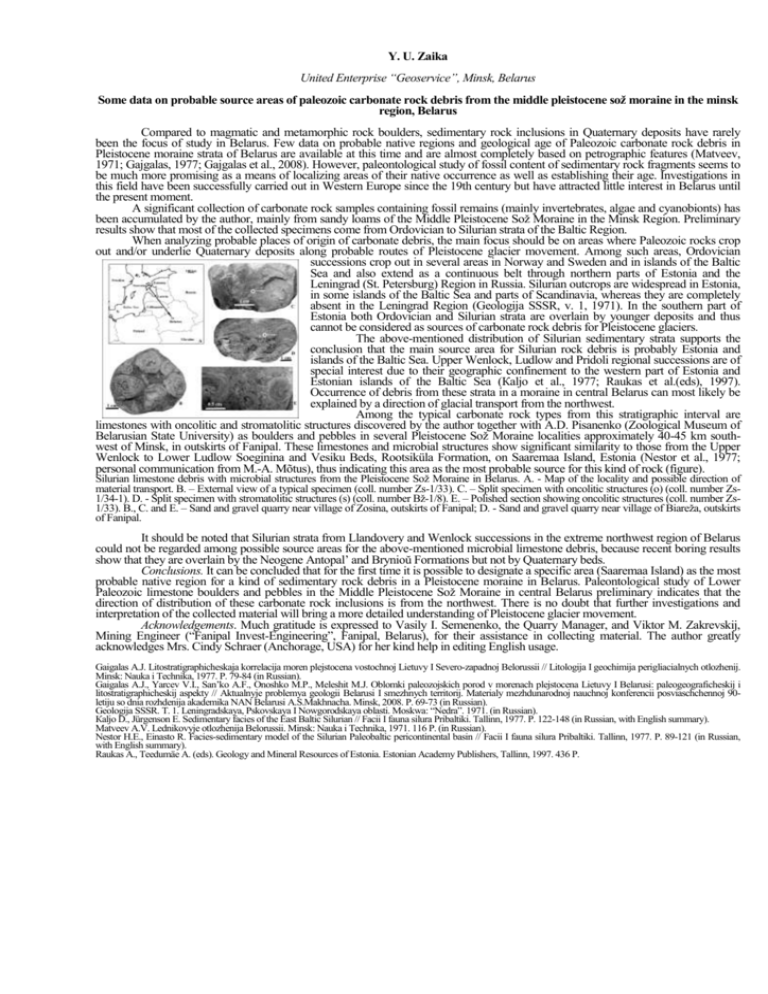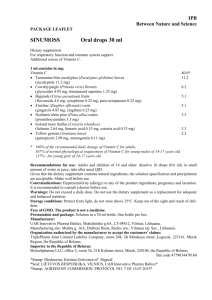younger deposits
advertisement

Y. U. Zaika United Enterprise “Geoservice”, Minsk, Belarus Some data on probable source areas of paleozoic carbonate rock debris from the middle pleistocene sož moraine in the minsk region, Вelarus Compared to magmatic and metamorphic rock boulders, sedimentary rock inclusions in Quaternary deposits have rarely been the focus of study in Belarus. Few data on probable native regions and geological age of Paleozoic carbonate rock debris in Pleistocene moraine strata of Belarus are available at this time and are almost completely based on petrographic features (Matveev, 1971; Gajgalas, 1977; Gajgalas et al., 2008). However, paleontological study of fossil content of sedimentary rock fragments seems to be much more promising as a means of localizing areas of their native occurrence as well as establishing their age. Investigations in this field have been successfully carried out in Western Europe since the 19th century but have attracted little interest in Belarus until the present moment. A significant collection of carbonate rock samples containing fossil remains (mainly invertebrates, algae and cyanobionts) has been accumulated by the author, mainly from sandy loams of the Middle Pleistocene Sož Moraine in the Minsk Region. Preliminary results show that most of the collected specimens come from Ordovician to Silurian strata of the Baltic Region. When analyzing probable places of origin of carbonate debris, the main focus should be on areas where Paleozoic rocks crop out and/or underlie Quaternary deposits along probable routes of Pleistocene glacier movement. Among such areas, Ordovician successions crop out in several areas in Norway and Sweden and in islands of the Baltic Sea and also extend as a continuous belt through northern parts of Estonia and the Leningrad (St. Petersburg) Region in Russia. Silurian outcrops are widespread in Estonia, in some islands of the Baltic Sea and parts of Scandinavia, whereas they are completely absent in the Leningrad Region (Geologija SSSR, v. 1, 1971). In the southern part of Estonia both Ordovician and Silurian strata are overlain by younger deposits and thus cannot be considered as sources of carbonate rock debris for Pleistocene glaciers. The above-mentioned distribution of Silurian sedimentary strata supports the conclusion that the main source area for Silurian rock debris is probably Estonia and islands of the Baltic Sea. Upper Wenlock, Ludlow and Pridoli regional successions are of special interest due to their geographic confinement to the western part of Estonia and Estonian islands of the Baltic Sea (Каljo et al., 1977; Raukas et al.(eds), 1997). Occurrence of debris from these strata in a moraine in central Belarus can most likely be explained by a direction of glacial transport from the northwest. Among the typical carbonate rock types from this stratigraphic interval are limestones with oncolitic and stromatolitic structures discovered by the author together with A.D. Pisanenko (Zoological Museum of Belarusian State University) as boulders and pebbles in several Pleistocene Sož Moraine localities approximately 40-45 km southwest of Minsk, in outskirts of Fanipal. These limestones and microbial structures show significant similarity to those from the Upper Wenlock to Lower Ludlow Soeginina and Vesiku Beds, Rootsiküla Formation, on Saaremaa Island, Estonia (Nestor et al., 1977; personal communication from M.-A. Mõtus), thus indicating this area as the most probable source for this kind of rock (figure). Silurian limestone debris with microbial structures from the Pleistocene Sož Moraine in Belarus. A. - Map of the locality and possible direction of material transport. B. – External view of a typical specimen (coll. number Zs-1/33). C. – Split specimen with oncolitic structures (o) (coll. number Zs1/34-1). D. - Split specimen with stromatolitic structures (s) (coll. number Bž-1/8). E. – Polished section showing oncolitic structures (coll. number Zs1/33). B., C. and E. – Sand and gravel quarry near village of Zosina, outskirts of Fanipal; D. - Sand and gravel quarry near village of Biareža, outskirts of Fanipal. It should be noted that Silurian strata from Llandovery and Wenlock successions in the extreme northwest region of Belarus could not be regarded among possible source areas for the above-mentioned microbial limestone debris, because recent boring results show that they are overlain by the Neogene Antopal’ and Brynioŭ Formations but not by Quaternary beds. Conclusions. It can be concluded that for the first time it is possible to designate a specific area (Saaremaa Island) as the most probable native region for a kind of sedimentary rock debris in a Pleistocene moraine in Belarus. Paleontological study of Lower Paleozoic limestone boulders and pebbles in the Middle Pleistocene Sož Moraine in central Belarus preliminary indicates that the direction of distribution of these carbonate rock inclusions is from the northwest. There is no doubt that further investigations and interpretation of the collected material will bring a more detailed understanding of Pleistocene glacier movement. Acknowledgements. Much gratitude is expressed to Vasily I. Semenenko, the Quarry Manager, and Viktor M. Zakrevskij, Mining Engineer (“Fanipal Invest-Engineering”, Fanipal, Belarus), for their assistance in collecting material. The author greatly acknowledges Mrs. Cindy Schraer (Anchorage, USA) for her kind help in editing English usage. Gaigalas A.J. Litostratigraphicheskaja korrelacija moren plejstocena vostochnoj Lietuvy I Severo-zapadnoj Belorussii // Litologija I geochimija perigliacialnych otlozhenij. Minsk: Nauka i Technika, 1977. P. 79-84 (in Russian). Gaigalas A.J., Yarcev V.I., San’ko A.F., Onoshko M.P., Meleshit M.J. Oblomki paleozojskich porod v morenach plejstocena Lietuvy I Belarusi: paleogeograficheskij i litostratigraphicheskij aspekty // Aktualnyje problemya geologii Belarusi I smezhnych territorij. Materialy mezhdunarodnoj nauchnoj konferencii posviaschchennoj 90letiju so dnia rozhdenija akademika NAN Belarusi A.S.Makhnacha. Minsk, 2008. P. 69-73 (in Russian). Geologija SSSR. T. 1. Leningradskaya, Pskovskaya I Nowgorodskaya oblasti. Moskwa: “Nedra”. 1971. (in Russian). Каljo D., Jürgenson E. Sedimentary facies of the East Baltic Silurian // Facii I fauna silura Pribaltiki. Tallinn, 1977. P. 122-148 (in Russian, with English summary). Matveev A.V. Lednikovyje otlozhenija Belorussii. Minsk: Nauka i Technika, 1971. 116 P. (in Russian). Nestor H.E., Einasto R. Facies-sedimentary model of the Silurian Paleobaltic pericontinental basin // Facii I fauna silura Pribaltiki. Tallinn, 1977. P. 89-121 (in Russian, with English summary). Raukas A., Teedumäe A. (eds). Geology and Mineral Resources of Estonia. Estonian Academy Publishers, Tallinn, 1997. 436 P.





